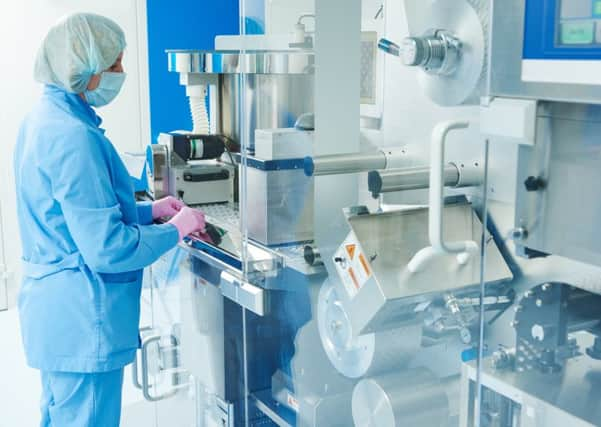Bill Jamieson: GDP rebound won’t let the good times roll


And there has been better news here in Scotland. Latest data revealed growth of 6.3 per cent (in cash terms) in Scottish GDP for 2018 as a whole, well above the UK growth level of 3.8 per cent. This, economist Professor John McLaren points out, is the fastest rate of growth seen since 2006, due to a revival in North Sea fortunes. However, in real terms, onshore growth was revised down to 1.3 per cent, just below the UK figure of 1.4. However, Scottish GDP per capita for 2018 as a whole is, for the fourth year running, very similar to that seen for the UK.
So scarce has been good news on the UK economy for the past two years, I’m reluctant to rush forward to cast doubt on the upbeat numbers released last Friday. But, as with the GDP measure generally, doubts there certainly are.
Advertisement
Hide AdAdvertisement
Hide AdFirst, the figures have almost certainly been affected by manufacturers’ stockpiling ahead of Brexit. This will have helped to boost this “growth” measure. The manufacturing sector grew at its fastest rate since 1988 over the period, driven, says the Office for National Statistics (ONS), by manufacturers rushing to deliver orders before the original Brexit deadline of 29 March.
The pharmaceuticals sector was one of the most seriously affected as distributors sought to ensure supplies in the event of border delays and disruption. The sector rose 9.4 per cent between January and March.
Previous business surveys had shown manufacturers stockpiling goods for Brexit in case the UK left the EU without a transition deal, which they feared could lead to supply chaos.
The problem here is more than just one of a brief “flash in the pan”. Subsequent quarters are likely to see firms running down their Brexit stockpile which will act as a drag on future GDP readings.
Now, there is some evidence that the economy did show underlying growth stronger than for several quarters – and certainly better than the Brexit gloom-mongers have been predicting.
But there have certainly been higher imports than normal. The trade deficit doubled during the quarter, from £8.9 billion to £18.3bn. And the trade in goods deficit ballooned £6.4bn to a record £43.3bn. The figure includes non-monetary gold which some might argue is irrelevant to our broader economic condition. But purchases of gold can be seen as a measure of an anxiety factor which is certainly evident across the economy.
There are other problems, too, with this measure. There is an evident disconnect between GDP as a measure of activity and how businesses and households alike actually feel about their situation. We know from the high streets that, up till the warm weather spell of the Easter weekend, consumer confidence has been weak by historic standards. We also know from survey data that business investment has fallen to worryingly low levels. In fact, it fell in all four quarters of last year to complete a year-on-year dive of 2.4 per cent, according to the ONS.
Weaker global growth and the UK-specific factor of Brexit are the most commonly cited causes. Companies are simply holding off from major investment and expansion decisions until there is more clarity over Brexit. Not only is there no sign of any early clarification, but an explosive display of voter anger in the upcoming Euro elections in two weeks and the growing likelihood of a Conservative Party meltdown and general election are likely to see further business caution and investment postponement. Few expect investment for the first half of 2019 to look stronger.
Advertisement
Hide AdAdvertisement
Hide AdIn the words of Jürgen Maier, who runs the UK factories of German industrial giant Siemens: “I personally can no longer defend the action of our parliament when reporting to my managing board, making it hard to win support for finely balanced investment decisions that in the end have an impact on UK jobs, innovation and the competitiveness of our activities here.”
Business commentator Martin Vander Weyer believes the pattern of actual investment is even more worrying – investing more in non-residential buildings (from warehouses to office blocks) but less in “ICT equipment and other machinery” and “intellectual property products”, which means software, R&D and factory robotics, in which we already trail behind the rest of the G7.
Even without Brexit distortions, GDP may not reflect the experience of households and individuals. An ONS “well-being dashboard” monitors such items as incomes, debt and anxiety levels – incomes may be rising, but so, too, are the other items.
Then there are other factors such as crime, gender equality, biodiversity, access to clean energy and education levels, which all impact both on our living standards and general sense of well-being.
Meanwhile, the decision to postpone Brexit looks to have impacted the latest April purchasing managers survey with a further fall in new business and reduced backlogs of work. New business has now contracted for four successive months.
And a weak April CBI industrial trends survey points to the manufacturing sector struggling at the start of the second quarter, with lacklustre underlying domestic demand and weakened orders from overseas. The orders balance fell to a six-month low in April, while manufacturers’ expectations for production over the next three months moved into negative territory for the first time since last October. The quarterly survey shows stockpiling of raw materials and finished goods by manufacturers rose at the fastest rate since records began in the 1950s in the three months to April. It also showed relatively weak manufacturers’ confidence and “poor” investment intentions. There is also concern that a lack of available skilled labour could hold back investment.
Thus can the GDP measure flatter to deceive. Happy days are here again? Not yet awhile.